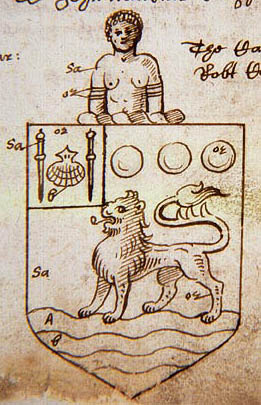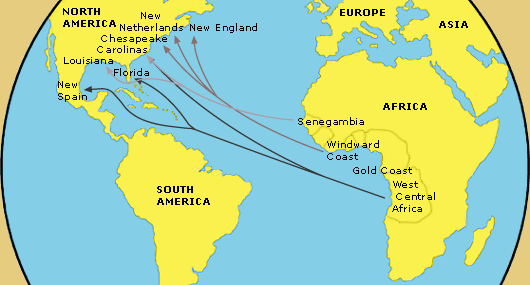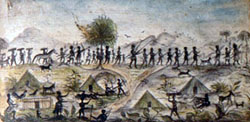The Transatlantic Slave Trade
The 9th through the 15th centuries were times of great struggle in Europe. The European powers struggled with one another for territorial and commercial dominance. Western and Eastern Christendom struggled with one another and with Islam for religious and cultural dominance.
The struggle for religious dominance resulted in North African Berbers, Mid-Eastern Arabs and other Muslim peoples from Morocco occupying the Iberian Peninsula for 700 years from 712 A.D. to 1492 A.D. During this time, while the Iberian powers sought to free themselves of Moorish occupation, England and France embarked on the Crusades to retake the Holy Land from Muslims, whom Christians called the “infidels.”
The periods of the 9th to 15th centuries were also times of external warfare among European powers over trade, the decline of chiefdoms, and of internal consolidation, all leading to the emergence of new European states. This era, which anthropologist Eric Wolf describes as the “crisis of feudalism,” was marked by the loss of agricultural productivity, famine, disease, and epidemics. Peasants rebelled against increased demands by nobility for tribute to pay for the wars. To resolve the emerging crisis, European nations increased the scale and intensity of Old World wars for commercial dominance. These circumstances combined to deplete the wealth of European nobility and the Church (Wolf 1982:108–125).
Economy and Religion
As the 15th century came to a close, Europeans embarked upon exploration of the New World and Africa in search of expanded territory, new goods, precious metals, and new markets. All of these enterprises required manpower to explore, clear land, build colonies, mine precious metals, and provide the settlers with subsistence. In the New World, Europeans first tried to meet these needs by enslaving American Indians and relying on European indentured laborers. When both of these sources proved inadequate to meet the needs for labor, Europe turned to Africa (Wolf 1982:108–125).
The Protestant Reformation and the Inquisition both indirectly influenced the development of the Transatlantic Slave Trade. At different times and in different nations, religious persecution by Catholics of Protestant sects, Protestant persecution of Catholics, and the Spanish Inquisition of Jews and other non-Christians led people to migrate to the New World to escape religious persecution. Many Christians believed that the conversion of the indigenous population to Christianity was imperative. Furthermore, by the early 16th century the Portuguese introduced Christianity to many West Central African peoples. Some of these people and their descendants enslaved and free lived on the Iberian Peninsula. For Europeans concerned with spreading Christianity, converted Africans were a more acceptable alternative labor supply than American Indians (Williams 1971).
In the New World, war, disease and famine among American Indians and the European settlers further depleted the colonies short labor supply. The development of economies based on production of sugar, tobacco and eventually rice were contingent upon workers with particular attributes of material cultural knowledge, agricultural skills and the physical capability to acclimate to the New World environment. Africans first enslaved by the Spanish and Portuguese demonstrated that they were people who fulfilled these requirements (Wolfe 1982:108–125).
In the 16th century, Spanish conquistadores sailed to the Americas lured by the prospects of finding gold. They brought a few Africans as slaves with them. Early Spanish settlers soon were reporting that in mining operations the work of one African was equal to that of four to eight Indians. They promoted the idea that Africans as slaves would be essential to production of goods needed for European colonization.
Several factors combined to give impetus to the Spanish demand for an African work force. Amerindians died in large numbers from European diseases for which they had no immunity. At the same time, the Spanish clergy interceded to the Spanish Crown to protect exploitation of Indians in mining operations. The introduction of sugarcane as a cash crop was another factor motivating the Spanish to enslave Africans. In order to turn a profit Spanish planters needed a large, controllable work force, they turned to Africa for laborers (Reynolds 2002:14).
Once Portugal and Spain established the profitability of the African slave trade, other European nations entered the field. The English made an initial foray into the African slave trade in 1530 when William Hawkins, a merchant of Plymouth, visited the Guinea Coast and left with a few slaves. Three decades later Hawkins’ son, John, set sail in 1564 for the Guinea Coast. Supported by Queen Elizabeth I, he commanded four armed ships and a force of one hundred and seventy men. Hawkins lost many of these men in fights with “Negroes” on the Guinea coast in his attempts to secure Africans to enslave. Later through piracy he took 300 Africans from a Spanish vessel, making it profitable for him to head for the West Indies where he could sell them for money and trade them for provisions. Queen Elizabeth I rewarded him for opening the slave trade for the English by knighting him and giving him a crest that showed a Negro’s head and bust with arms bound secure (Hale [1884] 1967 Vol. 3:60).
For more than a century after Columbus’s voyages, only Spain and Portugal established New World settlements. England did not establish its first enduring settlement in Jamestown, Virginia, until 1607. France founded a settlement in Quebec in 1608. Henry Hudson brought Africans with him in his Dutch sponsored exploration of the river that came to bear his name. Africans also accompanied the Dutch in 1621 when they established a trading post in the area of present day Albany.
Altogether, about 400,000 people migrated from England to the New World in the 16th and 18th centuries, including many farmers, small merchants, and artisans. Outside of New England, most European immigrants came to the colonies as indentured servants who agreed to serve a term of service in exchange for transportation across the Atlantic. English settlement itself took a variety of forms. In the Chesapeake region, the economy was structured around larger farms and plantations, relying on indentured servants, and later slave labor, to raise tobacco (Mintz 2003a). The Low Country region, also structured around large plantations, relied upon slave labor from its inception. After experimenting with livestock production and naval stores, planters in coastal South Carolina and later Georgia, developed an economy based on rice production. With the introduction of rice as a staple crop, South Carolina and Georgia colonists became even more reliant upon slave labor.
Northern colonies developed more diversified economies. The Dutch first traded in furs then later developed new economic activity in the production of food, timber, tobacco, and eventually, trade in people—slaves. Mid-Atlantic colonies developed grain commodities-based economies with centers in Philadelphia and New York that traded with other mainland and Caribbean colonies as well as England. Wealthy people in these colonies owned slaves and indentured servants, sometimes in considerable numbers. In New England the economy was based on fishing, small manufacturing, shipbuilding, rum distilleries and intra-coastal Caribbean and transatlantic commercial trade, not the least of which was transatlantic slave trade. New Englanders enslaved a few however their economic growth was heavily dependent upon the transatlantic slave trade (McCuster and Menard 1985).
Race as a Factor
European participation in African enslavement can only be partially explained by the needs for labor, profit, and religious motives. At the end of the medieval period, slavery was not widespread in Europe. It was mostly isolated in the southern fringes of the Mediterranean. Iberian Christians mostly enslaved Muslims, Jews, Gypsies, and Slavs. When the Transatlantic Slave Trade in Africans began in 1441, most Africans were placed in a new and different category of enslaveable peoples in terms that flowed from an understanding in the European world view of Africans as inferior human beings (Gomes 1936 in Sweet 2003:5). The policies and ideas that flowed from understandings of the African as inferior served to crystallize racial hierarchies across Europe (Sweet 2003:6). The first transnational, institutional endorsement of African slavery occurred in 1452 when the Pope granted King Alphonso V of Portugal the right to reduce all the non-Christians in West Africa to perpetual slavery (Saunders 1982:37–38 in Sweet 2003:6). According to Sweet, by the second half of the 15th century, the term “Negro” had become essentially synonymous with “slave” across the Iberian Peninsula and had literally come to represent a race of people, most often associated with black Africans and considered to be inferior (Sweet 2003:7). Race-based ideas of European superiority and religious beliefs in the need to Christianize “heathen” peoples contributed to a culture in which enslavement of Africans could be rationalized and justified. However, these explanations do not answer the question of why some Africans were complicity in the enslavement of other Africans in the transatlantic slave trade?
Internal African Conflicts and Complexities
Western and African historians agree that war captives, condemned criminals, debtors, aliens, famine victims, and political dissidents were subject to enslavement within West African societies. They also agree that during the period of the transatlantic slave trade, internal wars, crop failure, drought, famine, political instability, small-scale raiding, taxation, and judicial or religious punishment produced a large number of enslaved people within African states, nations and principalities. There is general agreement among scholars that the capture and sale of Africans for enslavement was primarily carried out by the Africans themselves, especially the coastal kings and the elders, and that few Europeans ever actually marched inland and captured slaves themselves (Boahen, 1966; Birmingham 1981; Wolf 1985; Mintz 2003). In spite of this agreement, contemporary historiography of the transatlantic slave trade attribute greater complicity of Africans than did earlier histories and primary source documents such as the ship log of Sir John Hawkins. Although the historical complexities that contributed to African participation in the transatlantic slave trade can hardly be teased apart 400 years later, it is fair to say that internal African wars were the most important source of enslavement. It is also fair to say that had there been no European demand for African slave labor in the New World, there would not have been any market for an African labor supply.
Slave trade within Africa predated European contact. In the mid-1400s, the Portuguese learned how to navigate the Atlantic and worked their way down the West Coast of Africa buying people for enslavement in Europe. The slave trade to Europe began to decrease in the late 1400s with the Portuguese development of sugar plantations in the Atlantic islands of Madeira and São Tome, two islands, located off the West African coast. Much of the earliest European trade with West Africa was in gold, not people and took place in trading forts called castles located along the West African coast of present day Ghana. Later the trade in the forts shifted from gold to people.
As the New World demand for labor increased over the 17th century, the value of European goods traded for African people surpassed the value of goods exchanged for gold. The transatlantic slave trade was in full swing.
Who were enslaved and Why?
As a concomitant of the rise and fall of various African rulers and ruling parties, their political opponents, people of high social status, and their families were sold to promote internal political stability. Poor people were sold to reconcile debts owed by themselves or their families. Chiefs sold people as punishment for crimes. Gangs of Africans and a few marauding Europeans captured free Africans who were also sold into slavery. Domestic slaves were resold and prisoners of war were sold. However, Boahen, an African scholar, asserts, “The greatest sources to supply slaves were raids conducted for the sole purpose of catching men for sale and above all, inter-tribal and inter-state wars which produced thousands of war captives, most of whom found their way to the New World (Boahen 1966:110).”
All of these African people were bartered for European trade goods. A slave purchased for 100 gallons of rum worth only £10 could be sold for £20 to £50 in 17th century America. England regarded the slave trade with such importance that as part of the 1713 peace of Utrecht, England insisted she be awarded thirty years exclusive rights to transport Africans to Spanish colonies in America. This was before the slave trade was fully developed in the 18th century (Brawley 1981:8–9).
The slave trade was greatly encouraged by the low cost of slaves. Even though the price of slaves rose three- or four-fold during the 18th century, many Europeans were convinced that it was “cheaper to buy than to breed.” Between the 16th and mid-18th centuries, it was cheaper to import a slave from Africa than to raise a child to the age of 14. During the late 17th century, merchants in the Senegambia region of West Africa paid as little as one pound sterling for young males, which they sold to European traders for the equivalent of three-and-a-half pounds sterling, or 11 muskets, 31 gallons of brandy, or 93 pounds of wrought iron. Initially, many slaves were acquired from regions within fifty or a hundred miles of the West African coast. During the 18th century, however, rising prices led slavers to search for captives in interior regions, 500 to 1,000 miles inland (Mintz, Stephen 2003b).
Just as there were wars between Europeans over the right to slave catchment areas and points of disembarkation, there were increasing numbers of wars between African principalities as the slave trade progressed. Whatever the ostensible causes for these wars, they resulted in prisoners of war that supplied slave factories at Goree and Bance Islands, Elmina, Cape Coast Castle, and James Forts and at Fernando Po along the West and West Central African coast.
The fighting between African societies followed a pattern. Wars weakened the centralized African governments and undermined the authority of associations, societies, and the elders who exercised social control in societies with decentralized political forms. The winners and losers in wars both experienced the loss of people from niches in lineages, secret societies, associations, guilds and other networks that maintained social order. Conflict brought about loss of population and seriously compromised indigenous production of material goods, cash crops and subsistence crops. Seventeenth century Capuchin monks reported that the Angolan Ndongo slave catchment area was rapidly becoming a wasteland as a result of slave trading induced wars and raids that decimated the population (Birmingham 1981:37). According to them, by the end of the 17th century the area was a wasteland depopulated by slave exports, deaths during wars or slave transit to slaving depots, and as a result of mass out migrations of people fleeing in advance of the slave catching warriors (1981:38).
Winners and losers in the African wars came to rely upon European trade goods
more and more. Eventually the European monetized system replaced cowrie shells
as a medium of exchange. European trade goods supplanted former African reliance
on indigenous material goods, natural resources and products as the economic
basis of their society. At the same time Europeans increasingly required people
in exchange for trade goods. Once this stage was reached an African society
had little choice but to trade human lives for European goods and guns; guns
that had become necessary to wage wars for further captives in order to trade
for goods upon which an African society was now dependent (Birmingham 1981:
38).
While munitions contributed to the military prowess required by an African state
to control the slave trade, the effects of the trade on the other aspects of
African civilization and culture were far more devastating. African societies
lost kinship networks, agricultural laborers and production. The loss of people
meant the loss of indigenous artisans and craftsmen, along with the knowledge
of textile production, weaving and dying, metallurgy and metalwork, carving,
basket making, potting skills, architectural, and agricultural techniques upon
which their societies depended. Africa’s loss was the New World’s
gain. These were the same material cultural expertise and skills that Africans
brought to the New World along with their physical labor and ability to acclimate
to environmental conditions that made them indispensable in the development
of the Western Hemisphere.









